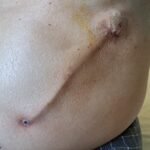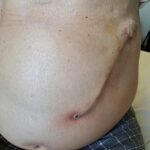Fully implantable permanent small chest drainage tube

The permanent thoracic drainage tubeCelsite Drainport) is a fully implantable silicone catheter system, whose drum is implanted in a newly created subcutaneous sheath in the region of the lateral arch and its inner end is inserted into the pleural or peritoneal cavity after a short subcutaneous route of a few centimetres.
The main indication for the system is recurrent, malignant lateral or ascitic effusion and trapped lung, as well as the administration of regional intra-abdominal chemotherapy. The surgical technique for its placement is short and is performed under local anaesthesia combined with mild sedation.
Description of technique
Connecting a patient to non-invasive cardiopulmonary monitoring. Sterilization of surgical field with povidone iodide solution and coating of adjacent area with aseptic monitors. Local infiltration of the area with anaesthetic d/ma and monitoring of anaesthesia adequacy. Diagnostic thoracentesis of the mediastinum with a 22G needle. If the thoracentesis is positive for fluid, proceed with a small skin and subcutaneous incision with a No. 11 blade in the thoracentesis area. Thoracentesis of the hemithorax and insertion of a guide wire into the pleural cavity (Seldinger technique). Local infiltration of a preselected adjacent area of the subcutaneous tube with anaesthetic d/ma and check for adequacy of anaesthesia. Small skin incision in the selected skin exit area of the tube with a N-bladeo11. Expander insertion and expander removal. Placing the sheath on the guide wire. Removing wire guide. Insertion of catheter through the sheath. Removal of the sheath. Re-check for correct positioning by fluoroscopy and check that the catheter is properly threaded. Local infiltration of the subclavian area of subcutaneous placement of the infusion device with anaesthetic d/ma and check for adequacy of anaesthesia. Skin and substrate incision with N bladeο15. Preparation of a substrate and creation of a space for the infusion device. Thorough hemostasis with electrothermal hemostasis. Sterilization of the case with povidone iodide solution. Creation of an appropriate subcutaneous tunnel connecting the infusion device to the catheter. Securely connect the catheter to the infusion device and place the infusion device in the subcutaneous sheath. Re-check for correct positioning by fluoroscopy and check that the device-carrier is properly seated. Stabilisation of the device in the sheath with two Silk No 2-0. Wound closure with individual Prolene N sutureso 3-0. Sterilization of the surgical field with povidone iodide solution. Re-check for correct positioning with the aid of fluoroscopy, check for proper device-fixing and heparinisation of the system. Coating of the surgical wound with dressing material. Transfer of the patient to his bed and ordering of a chest X-ray.
Instructions after installation
Imaging assessment
- Directly by chest X-ray (F+P)
- The morning of the next day with a chest X-ray (F+P)
Relevant medication and other treatment recommendations
- Broad-spectrum antibiotic treatment (e.g. tb cefuroxime 500mg 1X2 pos for 5 days)
- Analgesic treatment with a combination of non-steroidal, anti-inflammatory with mild opioids and simple analgesics (e.g. tb etoricoxib 60mg 1X1 pos, tb paracetamol 500mg - codeine 30mg 1X3 pos)
- Gastroprostacy (e.g. tb ranitidine 100mg 1X2 pos)
- Bronchodilator treatment (e.g. amp ipratropium-salbutamol + amp budesonide 1X4 neb)
- Mucolytic treatment (e.g. sachet acetylcysteine 600mg 1X2 pos)
- Wound re-examination and heparinization in two (2) days
- Daily wound care (antisepsis and dressing change) for five (5) days
- Suture removal in ten (10) days
- If an unexpected change is observed in the wound area (e.g. bleeding, redness, swelling, burning pain) or swelling of the corresponding upper limb, it is necessary to contact the attending physician.
- Satisfactory hydration
- Periodic monitoring of serum albumin levels in the blood and the administration of a hyperleukemic diet accordingly
- Respiratory physiotherapy (+ respiratory exercise instrument) and mobilisation
- Training of the patient and family members for home puncture of the device
- Reassessment by a specialist Thoracic Surgeon

You can arrange an appointment with the doctor
In the morning the Thoracic Surgeon, Dr Athanasios Kleontas MD is at the Interbalkan Medical Center of Thessaloniki, while in the evening he is at his private office (73, Ermou St).
+30 2310 - 400000
Office 11, 2nd floor. Dec 1742
ATHANASIOS D. KLEONTAS
PATIENT VISITATION HOURS
Doctor is available (by mobile) 24 hours a day, 7 days a week.
You meet him only by appointment at his private office:
Monday to Friday : 18.00 - 21.00



